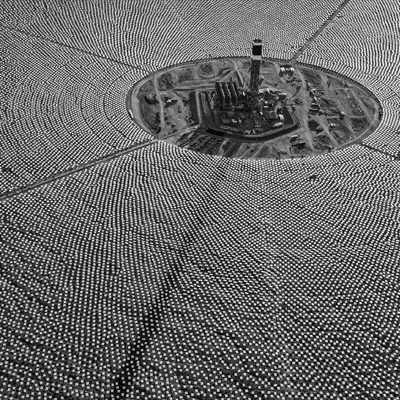I keep my sunny side up (sunny side)
So they can see me from above (ooh)
I keep my sunny side up (sunny side)
No more runnin' from the love, no more, no more
I keep my sunny side up (sunny side)
So they can see me from above
I keep my sunny side, oh
No more runnin' from the love…
Official song lyrics/audio For “Sunny Side Up” by Surfaces
Why go solar?
There's one simple fact that may just change your thoughts on renewable power. In a single hour, the amount of power from the sun that strikes the Earth is more than the entire world consumes in a year. Might be this is one of the many reasons many cultures worship the sun.
To put that in numbers, from the US Department of Energy: Each hour 430 quintillion Joules of energy from the sun hits the Earth. That's 430 with 18 zeroes after it. In comparison, the total amount of energy that all humans use in a year is 410 quintillion Joules.
Clearly, we have a source of virtually unlimited (the sun won't die out for another 5 billion years or so) clean energy in the form of solar power — we're just not capturing it. The current world population is 7.9 billion as of April 2021, out of which more than 2.8 billion population lives without household electricity.
Recently, (silicon) solar photovoltaics (PV) has become the cheapest source of electrical power in regions that have high solar potential - price bids have been as low as 0.01567 US$/kWh in 2021.
The following world map shows countries/regions where the production of electricity from solar (countries marked in yellow color) and onshore wind (marked in blue color) are cheaper than energy production from conventional fossil fuels.
Source: News BlombergNEF, 1-megawatt hour = approximate energy for 300 homes
Solar is and will dominate
In the coming years, it is evident and forecasted (represented in the graph below) that solar energy will become a prominent and reliable source for the supply of electricity.
SolarPower Europe (2019). Global Market Outlook for Solar Power / 2019 - 2023
However, there remain several challenges to be addressed – the sun is not always shining bright, for instance, in many northern countries, including the UK, sunshine is scarce. So it's not surprising that one of the most common questions asked is - How we will be able to harvest sunlight to produce enough electricity in such countries?
Moreover, it is also evident that in the future, cities will be increasingly dominated by skyscrapers. As a result of skyscrapers overshadowing rooftops, solar cells will face scarcity of sunlight.
This raises a further question...
Is silicon PV really the way to go?
Silicon PV has several disadvantages, a couple of important hurdles to consider are:
- Silicon lacks the flexibility to fine-tune its optical bandgap hence we can only harvest a particular part of the solar spectrum. Silicon is transparent at wavelengths longer than 1.1 microns (1100 nm) 23% of sunlight passes right through with no effect.
- Due to the high crystalline and rigid structure of silicon it is extremely prone to damage caused by external factors - weather, external shock, etc. In simple words, a small bit of damage to a solar panel will be detrimental to the overall performance of the panel and will require the entire panel to be replaced.
Dr Sagar Jain is leading a photovoltaics and optoelectronic research group at Cranfield University. Their recent research focuses on the investigation of a new kind of solar cell material called “perovskite”(famously known as a wonder material) to be used efficiently in solar cells known as perovskite solar cells.
Perovskite solar cells were invented over a decade ago and are already a significant competitor to silicon PV in terms of performance. The certified efficiency of perovskite solar cells is 25.5%, outperforming commercial silicon solar cell efficiency of 24.5%. This high performance is possible due to the suitable optoelectronic properties of perovskite material that are employed in these new types of solar cells.
Generating electricity by harvesting low intensity sunlight or indoor light
Dr Jain and co-workers have experimentally shown (1-8) that, unlike conventional silicon PV, perovskite solar cells can be fine-tuned to harvest a broad spectrum of sunlight.
Light intensity (in lux) in different environments can be harvested using perovskite solar cells
In his research work - Jain et al, Adv. Energy, Mater 2018,8, 1801509, Dr Jain demonstrated that perovskite solar cells can be fine-tuned to efficiently harvest indoor light (200 lux to 1000 lux) to produce efficiency as high as 35% - a world record efficiency produced by the harvesting low light). This breakthrough in performance, and also the novel application of perovskite solar cells, has attracted huge attention from the worldwide scientific community working in the solar cell research field.
The impact of this research is that perovskite solar cells can be efficiently used to harvest indoor light to run internet of things (IOT) items, and they even have the capacity to satisfy electricity/energy requirements for the buildings, offices, and homes so that they become self-sustainable, energy-positive buildings.
Dr Jain is currently working on exploring a new type of perovskite material for smart applications, such as semi-transparent to transparent solar cells and light-emitting diodes to be used in futuristic smart city infrastructures, as well as the fabrication of flexible perovskite solar cells to be used in various lightweight applications.
References
- Jain et al, Adv. Energy, Mater 2018,8, 1801509
- Jain et al, Solar energy 2021, volume 217, 165-172
- Jain et al, Adv. Energy, Mater 2020, 10, 13, 2070057
- Jain et al., Advanced Electronic Materials 6 (4), 1900884
- Jain et al, Solar Energy 2020, 195, 436-445
- Jain et al, Organic Electronics 2019, 75, 105387
- Jain et al, Journal of material chemistry A 2019, 35,10234
- Jain et al., Communication Chemistry 2019, 91 (2)






